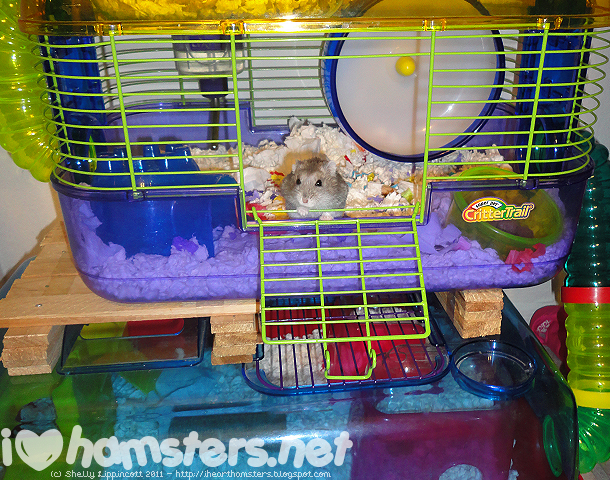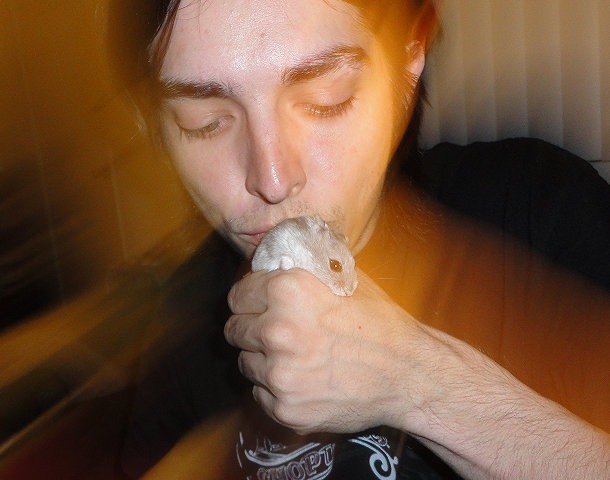How many times have you wandered by the cute hamsters in the pet shop and thought about getting one? Chances are you've done it at least once! Hamsters can make a great pet for people, but are casually cast aside as an easy children’s pet. Each species is different, and some may not be the best choice for you.
Syrians are the most popular species of hamster kept as pets. Sometimes the pet shops label them as "Teddy Bear". Syrians come in a wide variety of color and coat patterns, including long and short hair. Adult hamsters usually grow to be between 7-9 inches long with a short tail. Syrians are solitary animals, and only come together in the wild to mate. After the age of 8 weeks, all Syrian hamsters should be kept in separate habitats. Syrian hamsters use their scent glands located on their hips to mark their territory. They are also the slowest. If getting a hamster for a child, a Syrian would be the wisest choice. Be warned, Syrians do not like light, and sleep almost all day. Youngsters can be quite jumpy while being handled. They require a wheel of at least 8 inches in diameter. Syrians are very good housekeepers, and will usually designate an area of the cage for storing food and using the bathroom. Syrians can also be vocal hamsters, with some being more of a chatter box than others.
Once believed to be one species, the Campbells and the Winter White are actually two species commonly referred to as the Russian dwarf hamster. These two species are capable of interbreeding. Interbreeding the two can cause sterilization, and diseases previously seen in only one species are found in both. Also, the female always needs to be a Campbells because they have larger heads and Winter Whites will have trouble giving birth. Pet-shops never label them as hybrids, so they are usually sold to customers as one or the other. Because of both unsuspecting owners not realizing they own a hybrid, and the popularity of interbreeding for new color combinations, the Campbells and Winter Whites are declining. Both species are social and can live in groups if introduced young. Just because they can live together, doesn't mean they will get along with each other, let alone members of the same species. Both species can be prone to diabetes. Sugary foods such as corn, peas, and carrots should be kept to an absolute minimum. Signs of diabetes include frequent urination and heavy drinking. Hamsters can be tested for diabetes using human test strips.
Campbells are more popular than Winter Whites. They are found in many colors varieties, such as Argente, Mottled, Umbrous and Platinum. Campbells have a distinct cream tint along the arches on their side with a thin dorsal stripe. Their eyes are the placed evenly between their nose and ears with a rounded face and furry feet. Campbells grow to be about 3-4 inches long, with the males being larger than the females. They are often referred to as being more outgoing with humans than its counterpart. Their eye sight is poor, and they rely heavily on their sense of hearing and smell to recognize their home environment. Some Campbells become territorial. This means they are protective of their habitat. If this happens, be patient with your hamster and use a tool as an elevator for scooping out the hamster. Campbells are most active at night and dusk, only waking during the day for brief moments.
Winter Whites get their name from the ability to change their coat to white during the winter season in order to camouflage in the wild. Winter Whites currently only come in a few colors; Agouti, Sapphire, and Pearl. They have a thick black dorsal stripe which widens around the shoulders, a bullet shaped body, and three distinct arches on their sides aligned with darker ticking. Their eyes are big and bold with a longer nose, and fur on their feet. They grow to be about 3-4 inches long. Winter Whites are usually more shy and timid than the Campbells. They love to have plenty of hide-a-ways to duck into when feeling insecure. They can dart away, though not as quickly as the Roborovski. When attempting to handle a Winter White, they may squeak and become defensive. This is different than aggression. Be gentle, and speak softly while handling. Like most other hamsters, Winter Whites are most active at night.
The smallest of the dwarf hamster species is the Roborovski hamster, commonly referred to as Robs or Robos. Roborovskis come in only a few colors, Agouti and White Faced, though new color mutations such as “Spotted/Pied” and “White” are slowly emerging. Roborovskis grow to be about 2 inches long. They are the fastest of the hamster species. They rarely stop moving, and because of this, do not make good pets for children and often end up in rescue shelters. They can be timid and do not tame like other hamsters, but are curious enough to walk across your hand while inside their cage. People misjudge them and think just because Roborovskis are so tiny that they do not require much space. This is false. Roborovskis do best in large set-ups. While their legs are tiny and thin, they are able to run many miles in one night. Their speed demon antics are entertaining, earning the nickname “Goldfish of the Hamsters”. Roborovskis rarely vocalize themselves and prefer for their habitat to be kept dark. Like the other dwarf species, Roborovskis can be kept in pairs if introduced properly.
The last species of hamster kept as a pet is the Chinese hamster. They are usually grouped together with the dwarf hamsters due to their size, but the Chinese hamster is not technically a dwarf hamster. They are not as common as the other hamster species because of their strict breeding conditions. California does not allow you to own or transport a Chinese hamster without a permit. Unlike other hamsters, the Chinese hamster has a long tail which they use for balance and grip. They love to climb and can jump real high, and do best in a cage that allows them to take advantage of these skills. Chinese hamsters grow to be about 4-5 inches long, with a slender body that resembles a mouse. They are usually a dark grey-brown with a dark dorsal stripe down their spine and a white underside. Chinese hamsters can be timid and fast-moving, but most of them have a good temperament.
The five hamster species can be quite different from each other. The Syrian hamster is the most popular, largest, and slowest. Campbells and Winter Whites have been interbred tremendously and there are a lot of hybrids on the market. Winter Whites are vocal and shy, and the Campbells are more outgoing. Roborovskis are the smallest and fastest, and do not make the best choice for children or inexperienced hamster owners. Chinese hamsters are not found in a lot of places, and have a long tail for climbing. Hopefully reading this guide has given you a better understanding of each of the species.














































